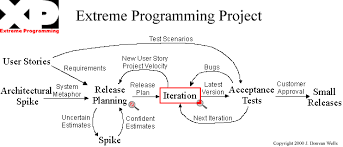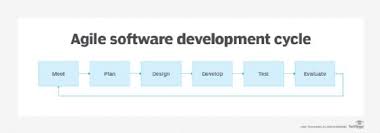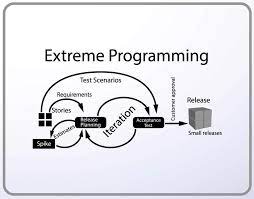XP Development: Embracing Agility for Software Success
In the world of software development, staying ahead of the curve is crucial. Traditional methods often fall short in delivering efficient and high-quality results within strict timelines. This is where XP (Extreme Programming) development comes into play, offering a unique and effective approach to software development.
XP development is an agile software engineering methodology that emphasizes collaboration, adaptability, and continuous improvement. It aims to deliver valuable software quickly while maintaining high standards of quality. By embracing XP, teams can overcome common challenges and achieve success in their projects.
One of the key principles of XP development is customer involvement. The customer becomes an active participant throughout the entire development process, providing feedback and clarifying requirements. This ensures that the end product meets their expectations and delivers real value. Regular communication between developers and customers helps to establish a shared understanding, fostering trust and collaboration.
Another important aspect of XP is its focus on simplicity. The methodology encourages developers to take a minimalist approach when designing solutions. By prioritizing simplicity, unnecessary complexities are avoided, making the codebase easier to understand, maintain, and enhance over time.
XP also promotes continuous integration and testing. Developers frequently integrate their work into a shared codebase to identify any conflicts or issues early on. Automated unit tests are written alongside the code to ensure that any changes do not introduce unintended side effects or break existing functionality. This proactive approach minimizes risks associated with system failures or regressions.
Pair programming is another distinctive feature of XP development. Two programmers work together at one workstation, collaborating on the same piece of code in real-time. This practice enhances knowledge sharing, improves code quality through constant peer review, reduces errors, and boosts team morale.
In addition to these core practices, XP encourages sustainable pace by advocating for reasonable working hours and avoiding excessive overtime or burnout situations. This ensures that team members stay motivated and productive throughout the project lifecycle.
Adopting XP development requires a shift in mindset and a commitment to embracing change. It empowers teams to respond quickly to evolving requirements, adapt to new challenges, and continuously improve their processes. By following the principles of XP, software development projects can achieve higher customer satisfaction, shorter time-to-market, and improved overall quality.
In conclusion, XP development offers a refreshing approach to software development that prioritizes collaboration, adaptability, and continuous improvement. By involving customers throughout the process, focusing on simplicity, practicing continuous integration and testing, embracing pair programming, and promoting sustainable pace, teams can deliver high-quality software within challenging timelines. Embracing XP can lead to greater success in software projects by fostering agility and efficiency in an ever-evolving industry.
5 Frequently Asked Questions about XP (Extreme Programming) Development
- What is XP (Extreme Programming) development?
- What are the advantages of XP development?
- How does XP development compare to other software development methodologies?
- What tools and techniques are used in XP development?
- What challenges do developers face when using XP development approaches?
What is XP (Extreme Programming) development?
Extreme Programming (XP) development is an agile software development methodology that aims to deliver high-quality software quickly and efficiently. It was created by Kent Beck in the late 1990s as a response to the challenges faced by traditional software development approaches.
XP emphasizes collaboration, adaptability, and continuous improvement throughout the entire development process. It focuses on delivering value to customers by prioritizing their needs and incorporating their feedback into the development cycle. XP also promotes a set of core practices that help teams achieve their goals effectively.
One of the key principles of XP is customer involvement. Customers are actively engaged in the development process, providing input, clarifying requirements, and participating in regular feedback sessions. This close collaboration ensures that the end product aligns with customer expectations and delivers maximum value.
XP encourages simplicity in design and implementation. It advocates for minimalistic solutions that address the immediate needs without unnecessary complexity. By keeping things simple, XP reduces the risk of errors, improves maintainability, and enhances overall productivity.
Continuous integration is another fundamental practice in XP. Developers frequently integrate their work into a shared codebase to identify conflicts or issues early on. This ensures that all changes are integrated smoothly and helps minimize integration problems down the line.
Test-driven development (TDD) is an essential part of XP. Developers write automated tests before writing code, ensuring that each piece of functionality is thoroughly tested. This approach helps catch bugs early, provides a safety net for refactoring code, and promotes overall code quality.
Pair programming is another distinctive feature of XP. Two programmers work together at one workstation, collaborating on the same piece of code in real-time. This practice fosters knowledge sharing, improves code quality through constant peer review, reduces errors, and boosts team morale.
XP also emphasizes a sustainable pace for developers. It encourages reasonable working hours and avoids excessive overtime or burnout situations. By maintaining a healthy work-life balance, team members can stay motivated and productive throughout the project.
Overall, XP development offers a flexible and adaptive approach to software development. By focusing on customer involvement, simplicity, continuous integration, test-driven development, pair programming, and sustainable pace, XP enables teams to deliver high-quality software efficiently while adapting to changing requirements and market demands.
What are the advantages of XP development?
XP (Extreme Programming) development offers several advantages that contribute to the success of software projects. Here are some key benefits of adopting XP:
- Enhanced Customer Satisfaction: XP emphasizes close collaboration with customers throughout the development process. By involving customers in decision-making, gathering regular feedback, and delivering working software incrementally, XP ensures that the final product meets their expectations and provides value. This leads to higher customer satisfaction and a stronger client-developer relationship.
- Faster Time-to-Market: XP promotes iterative and incremental development, allowing for rapid delivery of working software. By breaking down the project into smaller, manageable pieces called user stories, teams can prioritize and deliver valuable features sooner. This accelerated time-to-market gives organizations a competitive edge by quickly meeting customer needs and adapting to market changes.
- Improved Quality: The emphasis on continuous integration and testing in XP helps identify issues early in the development cycle. Frequent integration of code into a shared repository allows for early detection of conflicts or inconsistencies. Automated unit tests ensure that changes do not introduce regressions or unintended side effects. This focus on quality leads to more stable, reliable software with fewer bugs.
- Adaptability to Change: In today’s fast-paced business environment, requirements often evolve over time. XP embraces change by encouraging flexibility and responsiveness to new requirements or priorities. With short iterations and regular feedback loops, teams can easily accommodate changing customer needs or market demands without disrupting the entire project.
- Collaboration and Knowledge Sharing: Pair programming is a core practice in XP where two developers work together at one workstation on the same piece of code in real-time. This fosters collaboration, improves code quality through constant peer review, reduces errors, and promotes knowledge sharing within the team.
- Increased Developer Morale and Productivity: By promoting sustainable pace and avoiding excessive overtime or burnout situations, XP prioritizes developer well-being. This leads to increased job satisfaction, improved productivity levels, and higher-quality work. The focus on simplicity in XP also reduces complexity, making the codebase easier to understand and maintain.
- Continuous Improvement: XP encourages teams to reflect on their processes and make continuous improvements. Regular retrospectives provide an opportunity to identify areas for enhancement, learn from past experiences, and adapt practices accordingly. This commitment to continuous improvement ensures that teams evolve and deliver better results with each iteration.
In summary, XP development offers advantages such as enhanced customer satisfaction, faster time-to-market, improved quality, adaptability to change, collaboration and knowledge sharing among team members, increased developer morale and productivity, and a focus on continuous improvement. These benefits make XP a valuable methodology for successful software development projects.
How does XP development compare to other software development methodologies?
XP development stands out from other software development methodologies due to its unique set of practices and principles. Let’s compare XP to two popular methodologies: Waterfall and Agile.
1. Waterfall Methodology:
Waterfall follows a sequential, linear approach to software development. It involves distinct phases such as requirements gathering, design, implementation, testing, and deployment. Each phase is completed before moving on to the next one. Waterfall is known for its rigid structure and extensive documentation.
In contrast, XP embraces agility and flexibility. It encourages iterative development with frequent feedback loops between developers and customers. XP focuses on delivering working software in short iterations rather than waiting until the end of the project to deliver a complete product.
2. Agile Methodology (Scrum):
XP and Agile share similar values and principles, but they differ in some practices. Scrum, a popular Agile methodology, emphasizes self-organizing teams and time-boxed iterations called sprints.
XP incorporates additional practices like pair programming, continuous integration, test-driven development (TDD), and customer involvement throughout the process. These practices aim to enhance collaboration, code quality, adaptability, and customer satisfaction.
While Scrum focuses more on project management aspects like backlog prioritization and sprint planning, XP places equal emphasis on technical excellence through coding practices like TDD and pair programming.
Overall, XP can be seen as a subset of Agile methodologies that specifically addresses software engineering practices alongside project management aspects.
In comparison to Waterfall’s linear approach or Scrum’s focus on project management within Agile methodologies, XP stands out with its emphasis on customer involvement throughout the process, simplicity in design, continuous integration/testing, pair programming for knowledge sharing/reviewing code quality, sustainable pace for team well-being, and delivering working software frequently in short iterations.
By combining these unique practices with an agile mindset focused on adaptability and continuous improvement, XP provides a framework that enables teams to deliver high-quality software efficiently while meeting customer expectations.
What tools and techniques are used in XP development?
XP development utilizes a variety of tools and techniques to support its agile and collaborative approach. Here are some key tools and techniques commonly used in XP development:
- User Stories: User stories are concise, customer-centric descriptions of desired functionality. They serve as the basis for communication between developers and customers, capturing requirements in a simple and understandable format.
- Planning Game: The planning game is a collaborative activity where developers and customers prioritize user stories based on their value and estimate the effort required to implement them. This helps create a shared understanding of project goals and guides iterative planning.
- Continuous Integration: Continuous integration involves frequently integrating code changes into a shared repository. This practice is supported by tools like Jenkins, Travis CI, or GitLab CI/CD, which automate the process of building, testing, and deploying software changes.
- Test-Driven Development (TDD): TDD is a technique where developers write automated tests before writing the actual code. By following this approach, developers can ensure that their code meets the specified requirements while maintaining test coverage throughout the development process.
- Pair Programming: Pair programming involves two programmers working together at one workstation – one actively coding (the driver) while the other observes, reviews, and provides immediate feedback (the navigator). This technique promotes knowledge sharing, improves code quality through constant review, reduces errors, and enhances collaboration.
- Refactoring: Refactoring is the practice of improving existing code without changing its external behavior. Developers use refactoring techniques to enhance code readability, maintainability, and performance while keeping it aligned with evolving requirements.
- Simple Design: XP emphasizes simplicity in software design by favoring straightforward solutions over complex ones. Developers focus on creating clean code that fulfills current requirements without unnecessary complexity or premature optimization.
- Collective Code Ownership: In XP development teams, all members have equal responsibility for the entire codebase rather than individual components or modules. This encourages collaboration, knowledge sharing, and collective accountability for the quality and maintenance of the code.
- Onsite Customer: XP promotes having an onsite customer or a dedicated representative who is readily available to provide real-time feedback, clarify requirements, and make decisions. This ensures effective communication and reduces delays caused by unclear or changing requirements.
- Retrospectives: Retrospectives are regular team meetings where members reflect on their work process, identify areas for improvement, and plan adjustments for future iterations. These sessions foster continuous learning, encourage open communication, and drive ongoing process optimization.
These tools and techniques collectively support the core principles of XP development, enabling teams to deliver high-quality software in an iterative and collaborative manner while adapting to changing requirements.
What challenges do developers face when using XP development approaches?
While XP development brings numerous benefits, developers may encounter several challenges when implementing this approach. Here are some common challenges faced by developers using XP development:
- Cultural Shift: Adopting an XP mindset requires a cultural shift within the development team and the organization as a whole. Some team members may resist changes to their established practices, making it challenging to embrace new methodologies and practices.
- Customer Collaboration: While customer involvement is a core principle of XP, it can be challenging to ensure consistent and active participation from customers throughout the project. Scheduling conflicts or unavailability of key stakeholders can hinder effective collaboration.
- Changing Requirements: In an agile environment like XP, requirements can evolve rapidly. Developers must adapt to changing priorities and be flexible in accommodating new features or modifications while still meeting project deadlines.
- Balancing Simplicity and Complexity: Striking the right balance between simplicity and complexity can be challenging. Developers need to avoid over-engineering solutions while still ensuring that the software meets functional requirements and maintains scalability.
- Pair Programming Dynamics: Pair programming, a key practice in XP, requires effective collaboration between developers. It can be challenging to find compatible pairs who work well together and maintain productive working relationships throughout the project.
- Continuous Integration Challenges: Integrating code frequently can lead to conflicts or compatibility issues that need to be resolved promptly. Ensuring smooth integration among different modules or components can sometimes pose technical challenges.
- Test Coverage and Automation: Maintaining comprehensive test coverage and writing automated tests alongside code development is crucial in XP development. However, achieving sufficient test coverage while meeting project deadlines can be demanding for developers.
- Sustainable Pace: While sustainable pace is emphasized in XP, external pressures or tight deadlines may push developers towards overworking or compromising on quality standards. Striking a balance between productivity and sustainable workload is essential but can be challenging at times.
- Team Collaboration and Communication: Effective communication among team members is vital in XP development. Ensuring clear and constant communication, especially in distributed teams or when working remotely, can be challenging but is crucial for successful implementation.
- Resistance to Change: Introducing new methodologies and practices can face resistance from team members who are accustomed to traditional development approaches. Overcoming resistance and fostering a positive attitude towards change can be a significant challenge.
Despite these challenges, with proper planning, training, and support from management, developers can overcome obstacles and fully leverage the benefits of XP development. Open communication, continuous learning, and an adaptive mindset are key to successfully implementing XP practices within a development team.




